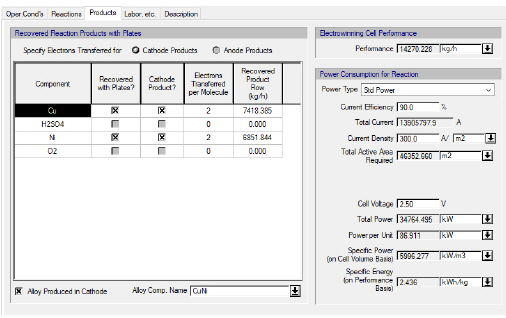

The following table shows a brief description of the variables appearing in this tab. The table also displays their default values and their generally acceptable range:
|
Variable |
Default Value |
Range |
|
|
||
|
○ Recovered with Plates ? |
<No> |
Positive |
|
○ Cathode Product ? |
<No> |
Positive |
|
○ Electrons Transferred Per Molecule |
0 |
PositiveInteger, |
|
● Recovered Product Flow (kg/h) |
0.0 |
Positive |
|
○ Alloy Produced in Cathode |
No |
Yes/No |
|
○ Alloy Comp. Name |
<None> |
Any Cathode Product Comp. |
|
● Performance (kg/h) |
0.0 |
Positive |
|
○ Power Type |
<Std Power> |
Any Power Type |
|
○ Current Efficiency(%) |
90.0 |
[0,100) |
|
● Total Current (A) |
0.0 |
Positive |
|
○ Current Density (A/m2) |
300.0 |
Positive |
|
● Total Active Area Required (m2) |
0.0 |
Positive |
|
○ Cell Voltage (V) |
1.5 |
Positive |
|
● Total Power (kW) |
0.0 |
Positive |
|
● Power Per Unit (kW) |
0.0 |
Positive |
|
● Specific Power (on Cell Volume Basis) (kW/m3) |
0.0 |
Positive |
|
● Specific Power (on Performance Basis) (kWh/kg) |
0.0 |
Positive |
Symbol Key: ○ User-specified value (always input); ● Calculated value (always output); ◙ Sometimes input, sometimes output
The following list describes the available specification choices in this tab; for more details on how these are implemented, see Cont. Stoich. Reaction in an Electrowininng Cell: Modeling Calculations.
•Electron Transfer Specification Options...
You may choose to specify the electrons transferred either for cathode products or for anode products. If the “Cathode Products” option is selected, then you can only edit the “Electrons Transfered Per Molecule” values of cathode product components (i.e., components whose “Recovered with Plates?” and “Cathode Product?” options are checked). If the “Anode Products” option is selected, then you can only edit the “Electrons Transfered Per Molecule” value of anode product components (i.e., components whose “Recovered with Plates?” option is checked but the “Cathode Product?” option is not checked).
•Components Table...
For each component that is recovered, either as a cathode product or as an anode product, you must check the “Recovered with Plates?” option. Also, if that component is a cathode product, you must check the “Cathode Product?” option, and if it is an anode product, you must leave the “Cathode Product?” option un-checked. Finally, you must specify the electrons transferred per molecule of all cathode product components, if the electron transfer is set for cathode products, or the electrons transferred per molecule of all anode product components, if the electron transfer is set for anode products.